Abstract
Integrated retroviruses or retroviral vectors may be transcriptionally inactive although their promoter-enhancer regions are able to direct transcription in the host cell. We have used single-gene retroviral vectors with a long terminal repeat-directed neo marker gene to determine if the level of transcription relates to the susceptibility of a provirus to inactivation. We used two isogenic vectors, carrying long terminal repeats with a strong and a weak transcriptional enhancer derived from SL3-3 and Akv murine leukemia viruses, respectively. Nonselected cell clones of the murine lymphoid cell line L691 with single integrated vector proviruses exhibiting a 20-fold range of initial expression levels were studied. The basal expression level of a given cell clone with a single provirus did not show any pattern of correlation with the long-term stability of expression, as monitored for periods up to 150 days. Our results thus indicate that the inactivation mechanism operates independently of the initial transcriptional activity of the provirus.
Full text
PDF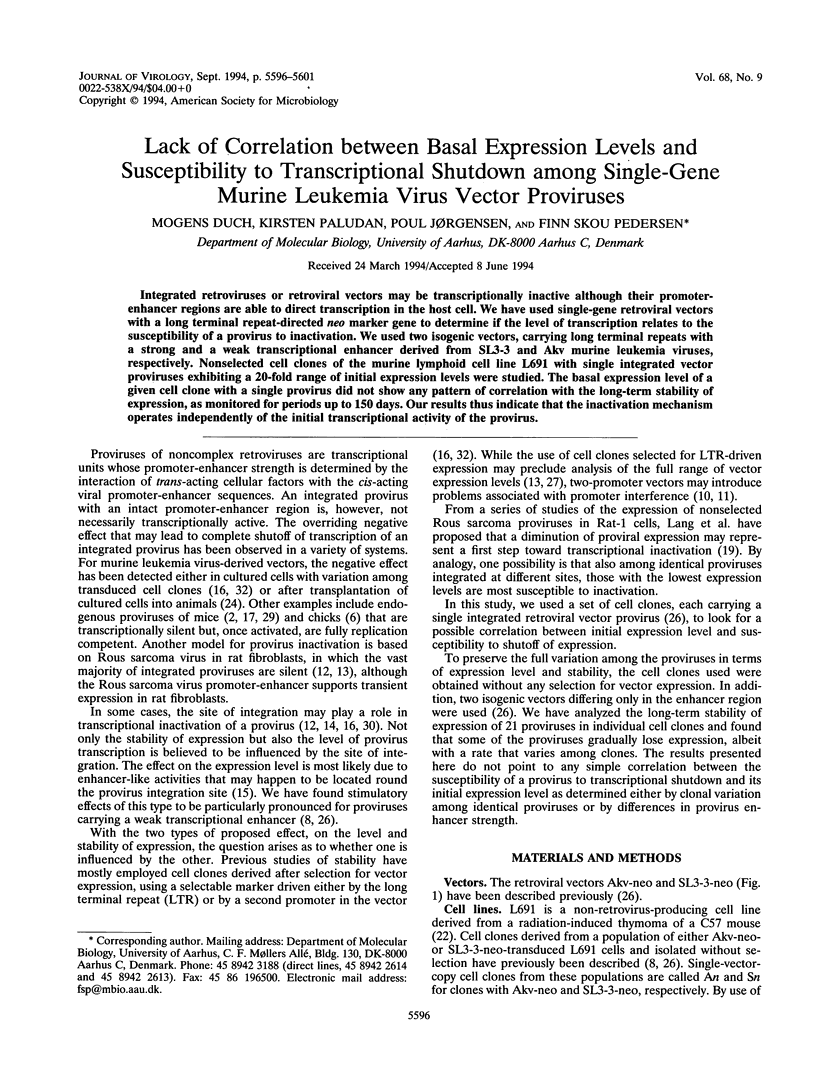
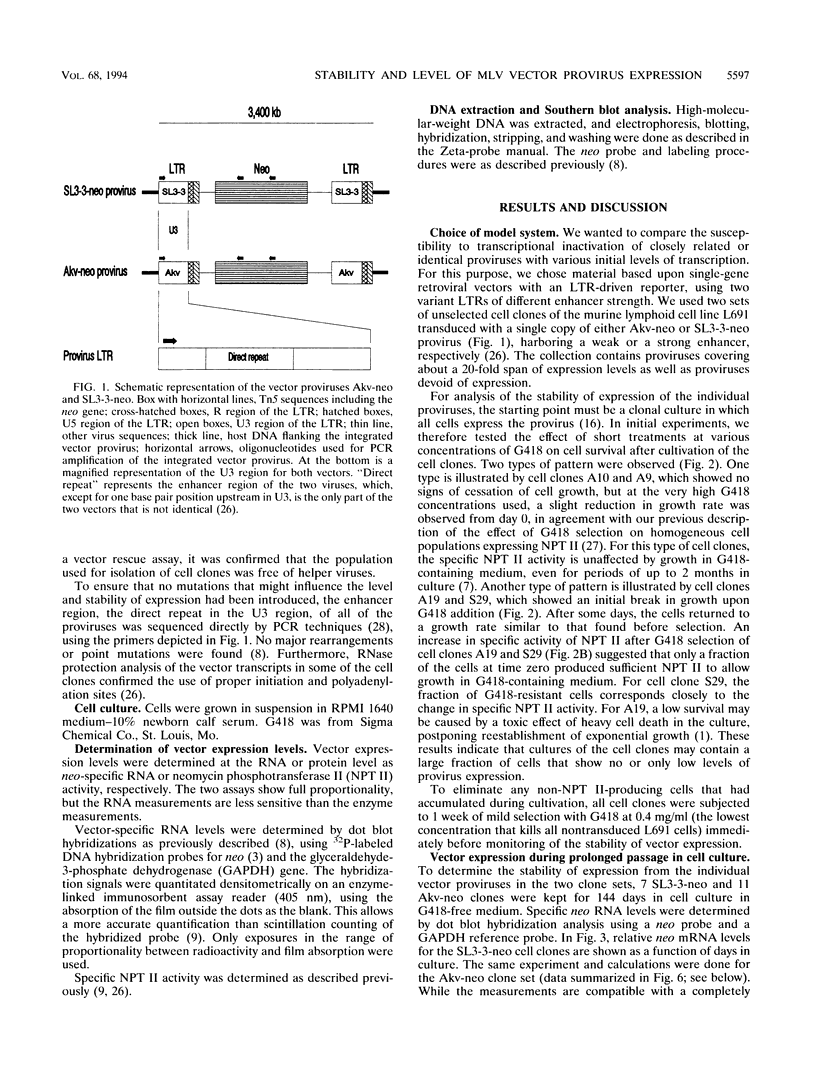
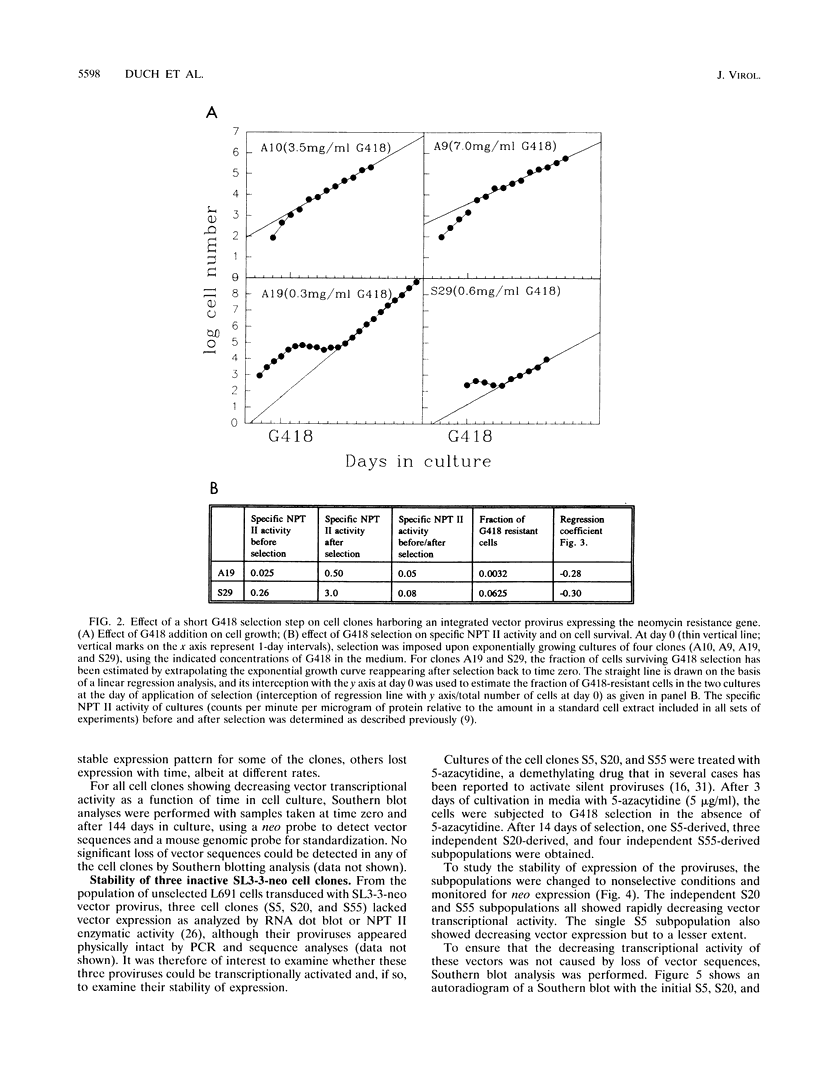
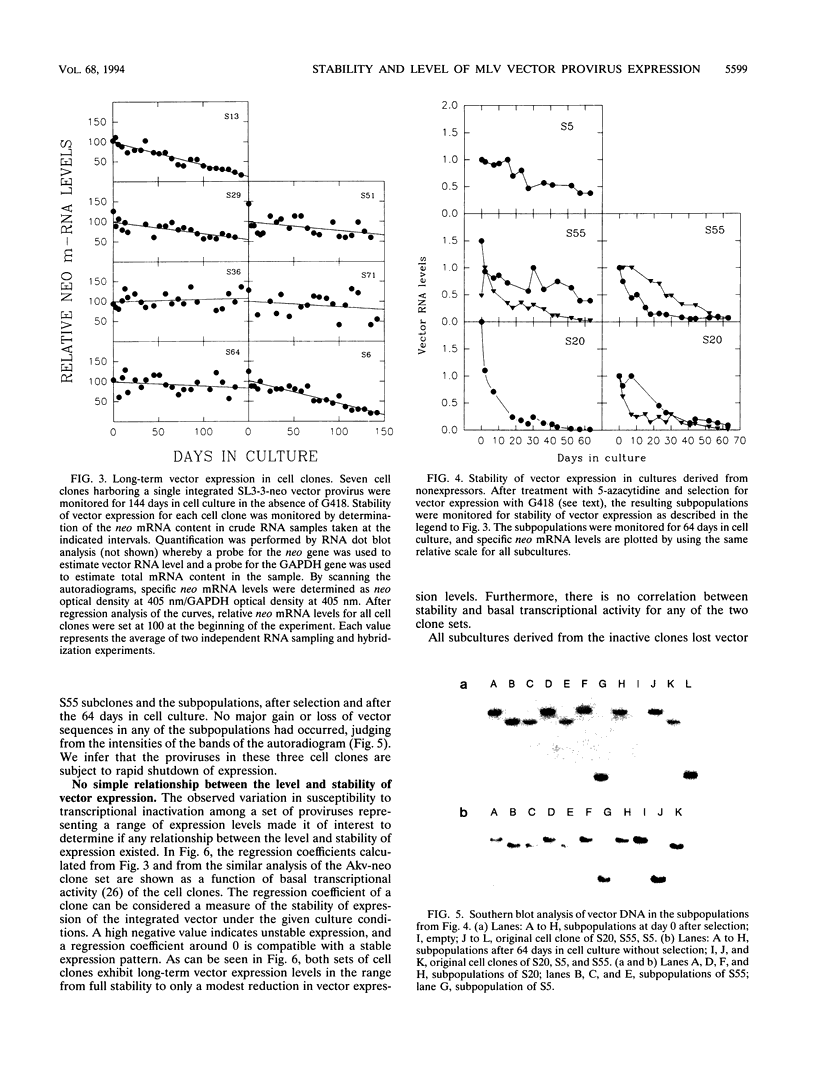
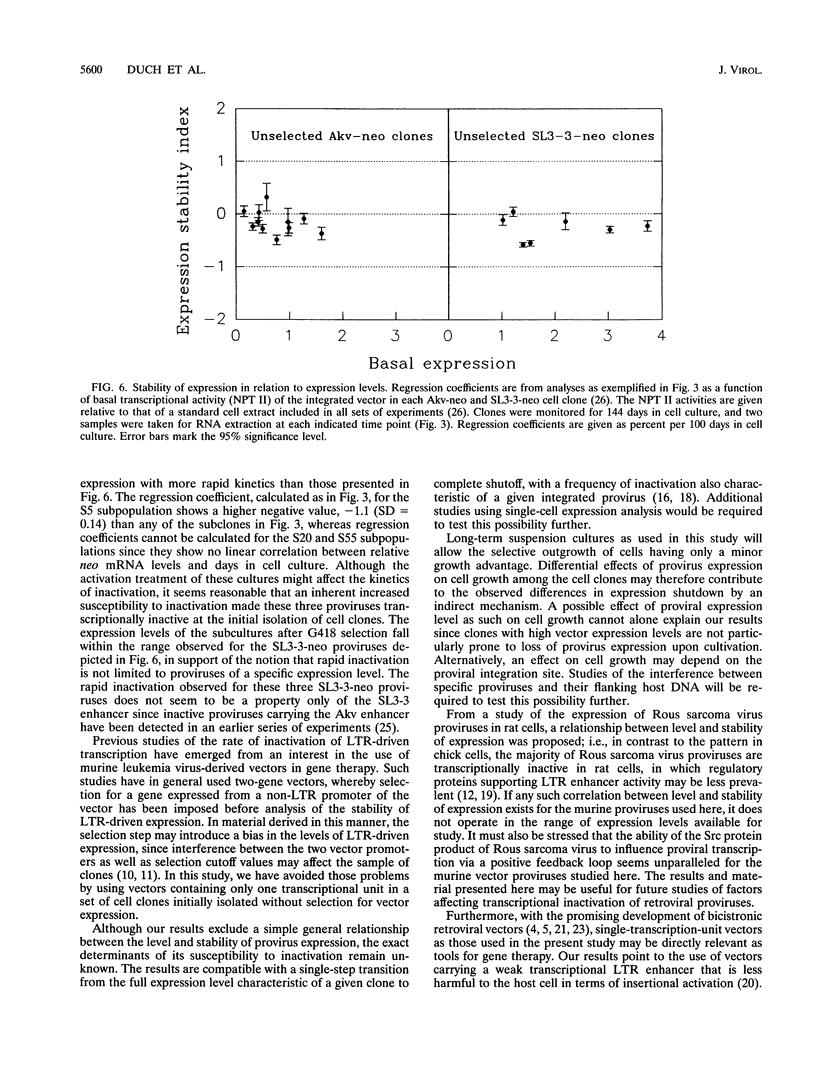
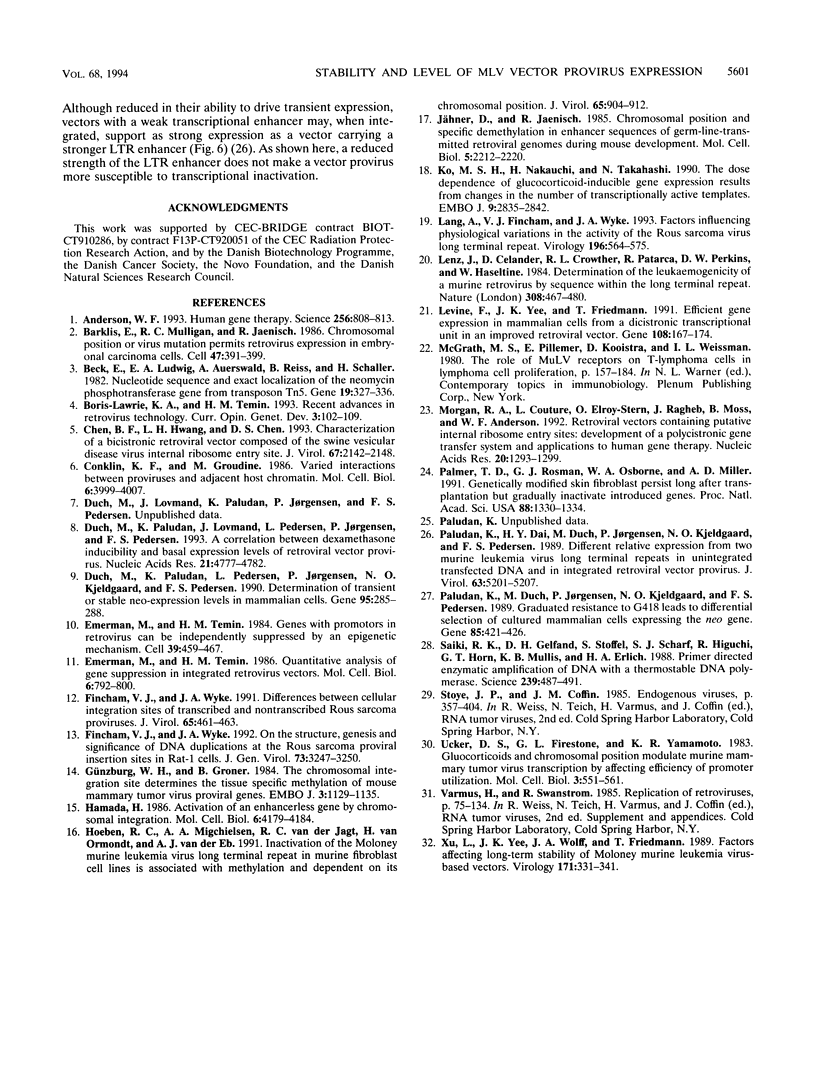
Images in this article
Selected References
These references are in PubMed. This may not be the complete list of references from this article.
- Anderson W. F. Human gene therapy. Science. 1992 May 8;256(5058):808–813. doi: 10.1126/science.1589762. [DOI] [PubMed] [Google Scholar]
- Barklis E., Mulligan R. C., Jaenisch R. Chromosomal position or virus mutation permits retrovirus expression in embryonal carcinoma cells. Cell. 1986 Nov 7;47(3):391–399. doi: 10.1016/0092-8674(86)90596-9. [DOI] [PubMed] [Google Scholar]
- Beck E., Ludwig G., Auerswald E. A., Reiss B., Schaller H. Nucleotide sequence and exact localization of the neomycin phosphotransferase gene from transposon Tn5. Gene. 1982 Oct;19(3):327–336. doi: 10.1016/0378-1119(82)90023-3. [DOI] [PubMed] [Google Scholar]
- Boris-Lawrie K. A., Temin H. M. Recent advances in retrovirus vector technology. Curr Opin Genet Dev. 1993 Feb;3(1):102–109. doi: 10.1016/s0959-437x(05)80349-1. [DOI] [PubMed] [Google Scholar]
- Chen B. F., Hwang L. H., Chen D. S. Characterization of a bicistronic retroviral vector composed of the swine vesicular disease virus internal ribosome entry site. J Virol. 1993 Apr;67(4):2142–2148. doi: 10.1128/jvi.67.4.2142-2148.1993. [DOI] [PMC free article] [PubMed] [Google Scholar]
- Conklin K. F., Groudine M. Varied interactions between proviruses and adjacent host chromatin. Mol Cell Biol. 1986 Nov;6(11):3999–4007. doi: 10.1128/mcb.6.11.3999. [DOI] [PMC free article] [PubMed] [Google Scholar]
- Duch M., Paludan K., Lovmand J., Pedersen L., Jørgensen P., Pedersen F. S. A correlation between dexamethasone inducibility and basal expression levels of retroviral vector proviruses. Nucleic Acids Res. 1993 Oct 11;21(20):4777–4782. doi: 10.1093/nar/21.20.4777. [DOI] [PMC free article] [PubMed] [Google Scholar]
- Duch M., Paludan K., Pedersen L., Jørgensen P., Kjeldgaard N. O., Pedersen F. S. Determination of transient or stable neo expression levels in mammalian cells. Gene. 1990 Nov 15;95(2):285–288. doi: 10.1016/0378-1119(90)90373-y. [DOI] [PubMed] [Google Scholar]
- Emerman M., Temin H. M. Genes with promoters in retrovirus vectors can be independently suppressed by an epigenetic mechanism. Cell. 1984 Dec;39(3 Pt 2):449–467. [PubMed] [Google Scholar]
- Emerman M., Temin H. M. Quantitative analysis of gene suppression in integrated retrovirus vectors. Mol Cell Biol. 1986 Mar;6(3):792–800. doi: 10.1128/mcb.6.3.792. [DOI] [PMC free article] [PubMed] [Google Scholar]
- Fincham V. J., Wyke J. A. Differences between cellular integration sites of transcribed and nontranscribed Rous sarcoma proviruses. J Virol. 1991 Jan;65(1):461–463. doi: 10.1128/jvi.65.1.461-463.1991. [DOI] [PMC free article] [PubMed] [Google Scholar]
- Fincham V. J., Wyke J. A. On the structure, genesis and significance of DNA duplications at the Rous sarcoma proviral insertion sites in Rat-1 cells. J Gen Virol. 1992 Dec;73(Pt 12):3247–3250. doi: 10.1099/0022-1317-73-12-3247. [DOI] [PubMed] [Google Scholar]
- Günzburg W. H., Groner B. The chromosomal integration site determines the tissue-specific methylation of mouse mammary tumour virus proviral genes. EMBO J. 1984 May;3(5):1129–1135. doi: 10.1002/j.1460-2075.1984.tb01941.x. [DOI] [PMC free article] [PubMed] [Google Scholar]
- Hamada H. Activation of an enhancerless gene by chromosomal integration. Mol Cell Biol. 1986 Dec;6(12):4179–4184. doi: 10.1128/mcb.6.12.4179. [DOI] [PMC free article] [PubMed] [Google Scholar]
- Hoeben R. C., Migchielsen A. A., van der Jagt R. C., van Ormondt H., van der Eb A. J. Inactivation of the Moloney murine leukemia virus long terminal repeat in murine fibroblast cell lines is associated with methylation and dependent on its chromosomal position. J Virol. 1991 Feb;65(2):904–912. doi: 10.1128/jvi.65.2.904-912.1991. [DOI] [PMC free article] [PubMed] [Google Scholar]
- Jähner D., Jaenisch R. Chromosomal position and specific demethylation in enhancer sequences of germ line-transmitted retroviral genomes during mouse development. Mol Cell Biol. 1985 Sep;5(9):2212–2220. doi: 10.1128/mcb.5.9.2212. [DOI] [PMC free article] [PubMed] [Google Scholar]
- Ko M. S., Nakauchi H., Takahashi N. The dose dependence of glucocorticoid-inducible gene expression results from changes in the number of transcriptionally active templates. EMBO J. 1990 Sep;9(9):2835–2842. doi: 10.1002/j.1460-2075.1990.tb07472.x. [DOI] [PMC free article] [PubMed] [Google Scholar]
- Lang A., Fincham V. J., Wyke J. A. Factors influencing physiological variations in the activity of the Rous sarcoma virus long terminal repeat. Virology. 1993 Oct;196(2):564–575. doi: 10.1006/viro.1993.1512. [DOI] [PubMed] [Google Scholar]
- Lenz J., Celander D., Crowther R. L., Patarca R., Perkins D. W., Haseltine W. A. Determination of the leukaemogenicity of a murine retrovirus by sequences within the long terminal repeat. 1984 Mar 29-Apr 4Nature. 308(5958):467–470. doi: 10.1038/308467a0. [DOI] [PubMed] [Google Scholar]
- Levine F., Yee J. K., Friedmann T. Efficient gene expression in mammalian cells from a dicistronic transcriptional unit in an improved retroviral vector. Gene. 1991 Dec 15;108(2):167–174. doi: 10.1016/0378-1119(91)90431-a. [DOI] [PubMed] [Google Scholar]
- McGrath M. S., Pillemer E., Kooistra D., Weissman I. L. The role of MuLV receptors on T-lymphoma cells in lymphoma cell proliferation. Contemp Top Immunobiol. 1980;11:157–184. doi: 10.1007/978-1-4684-3701-0_5. [DOI] [PubMed] [Google Scholar]
- Morgan R. A., Couture L., Elroy-Stein O., Ragheb J., Moss B., Anderson W. F. Retroviral vectors containing putative internal ribosome entry sites: development of a polycistronic gene transfer system and applications to human gene therapy. Nucleic Acids Res. 1992 Mar 25;20(6):1293–1299. doi: 10.1093/nar/20.6.1293. [DOI] [PMC free article] [PubMed] [Google Scholar]
- Palmer T. D., Rosman G. J., Osborne W. R., Miller A. D. Genetically modified skin fibroblasts persist long after transplantation but gradually inactivate introduced genes. Proc Natl Acad Sci U S A. 1991 Feb 15;88(4):1330–1334. doi: 10.1073/pnas.88.4.1330. [DOI] [PMC free article] [PubMed] [Google Scholar]
- Paludan K., Dai H. Y., Duch M., Jørgensen P., Kjeldgaard N. O., Pedersen F. S. Different relative expression from two murine leukemia virus long terminal repeats in unintegrated transfected DNA and in integrated retroviral vector proviruses. J Virol. 1989 Dec;63(12):5201–5207. doi: 10.1128/jvi.63.12.5201-5207.1989. [DOI] [PMC free article] [PubMed] [Google Scholar]
- Paludan K., Duch M., Jørgensen P., Kjeldgaard N. O., Pedersen F. S. Graduated resistance to G418 leads to differential selection of cultured mammalian cells expressing the neo gene. Gene. 1989 Dec 28;85(2):421–426. doi: 10.1016/0378-1119(89)90435-6. [DOI] [PubMed] [Google Scholar]
- Saiki R. K., Gelfand D. H., Stoffel S., Scharf S. J., Higuchi R., Horn G. T., Mullis K. B., Erlich H. A. Primer-directed enzymatic amplification of DNA with a thermostable DNA polymerase. Science. 1988 Jan 29;239(4839):487–491. doi: 10.1126/science.2448875. [DOI] [PubMed] [Google Scholar]
- Ucker D. S., Firestone G. L., Yamamoto K. R. Glucocorticoids and chromosomal position modulate murine mammary tumor virus transcription by affecting efficiency of promoter utilization. Mol Cell Biol. 1983 Apr;3(4):551–561. doi: 10.1128/mcb.3.4.551. [DOI] [PMC free article] [PubMed] [Google Scholar]
- Xu L., Yee J. K., Wolff J. A., Friedmann T. Factors affecting long-term stability of Moloney murine leukemia virus-based vectors. Virology. 1989 Aug;171(2):331–341. doi: 10.1016/0042-6822(89)90600-4. [DOI] [PubMed] [Google Scholar]



